Geography Pages
Maps of Russia
All boundaries, and borders of countries, are approximate
The territory controlled by a king or people varied from time to time, and was often disputed by other peoples. An approximation to the modern coast-line is generally used in the maps.
- Modern Russia and the World
- The early rulers of Russia
- The growth of Russia, from Alexander Nevski to the death of Boris Godunov, AD 1605
- The Romanov Dynasty
- Russia during the Romanov Dynasty
- Russia and America in 1866
- Go here for maps of Kievan Rus
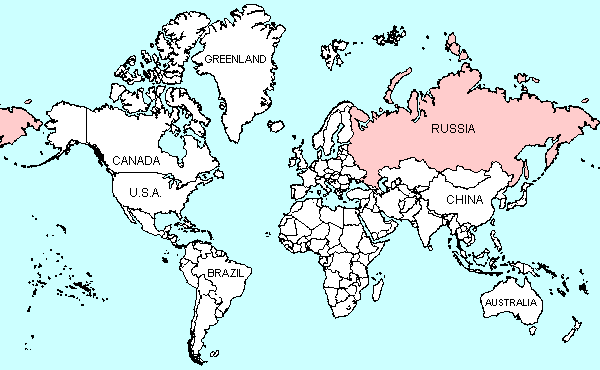
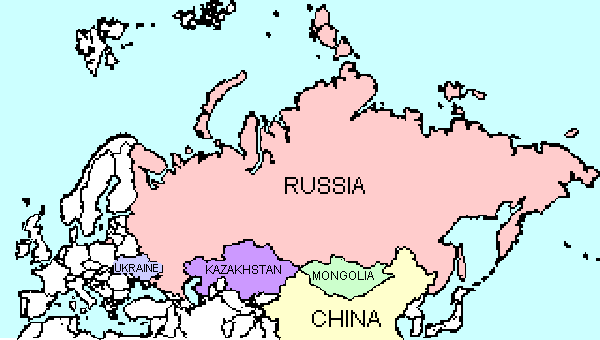
Russia is one of the largest countries in the world. It lies across both Europe and Asia, with the Ural Mountains dividing the country north-south between the two continents. There is a difficulty when drawing maps, in that it is not possible to represent accurately distances as measured on the spherical surface of the earth by distances on a two-dimensional plane
![]()
The early Princes of Russia were under the dominion of the Golden Horde until Ivan III the Great broke free in 1480 and refused to pay tribute
Princes of Russia, 1250 - 1605

The Growth of Russia, 1250 - 1605
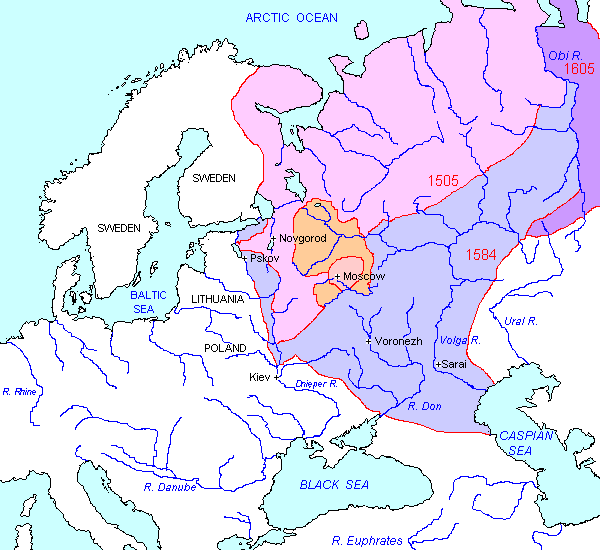
| Alexander Nevski, Prince or Grand Duke of Moscow, was one of several princes who held their appointments under the dominion of the Golden Horde. He held the people together and started to drive out foreign invaders but was not able to break free of the Tartars. | |
| Ivan III the Great came to the throne in 1462. By 1480 he was strong enough to break free of the Tartar Yoke and refused to pay tribute. He continued to build power, and by 1505 he had expanded his territory to include Novgorod and northern Russia up to the Ural Mountains | |
| Ivan the Great died in 1505. His son Vasili III and grandson Ivan the Terrible continued to expand the borders of Russia | |
| Ivan the Terrible died in 1584. He was succeeded by his son Fedor I, who was weak and under the control of his brother-in-law Boris Godunov. In 1598 Fedor I died without children, and Boris Godunov had himself elected as Tsar. Fedor I had had two brothers both named Dimitri. The older brother had died when he was 1 year old, but the younger one died under suspicious circumstances during Fedor's reign. Towards the end of Boris Godunov's reign at least four "False Dimitris" arose, claiming to be the younger brother, and leading revolts against Boris | |
| Boris Godunov died in 1605. His son Fedor II reigned for a couple of months before being murdered. The revolts of the various "False Dimitris" opened the way for Swedish and Polish armies to invade Russia, and a time of chaos ensued |
The Romanov Dynasty
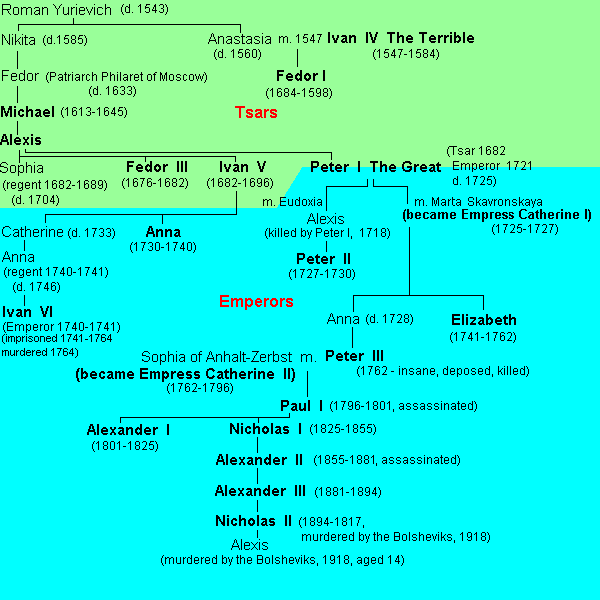
Russia under the Romanov Dynasty
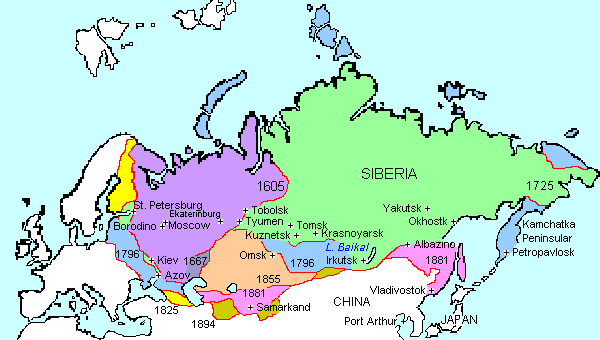
| After the deaths of Boris Godunov and his son Fedor II in 1605 there were eight years of revolts and invasions until the 17-year-old Michael Romanov was elected Tsar by the Zemski Sobor (equivalent of a Russian Parliament) | |
| The first years of the Romanov dynasty were taken up by securing internal peace and by trying to stop the fighting with Sweden and Poland. Peace treaties were signed with Sweden in 1617, and with Poland in 1619 and 1634; Russia had to give up some of her western territory. However, Poland collapsed in 1650, and Russia was able to regain territory and go on the offensive. By 1667 Russia had annexed some of the Cossack lands by the Dnieper | |
| Siberia had been part of the territory overrun by the Golden Horde. When the Mongol Empires fell into decay Russian and Cossack traders, soldiers, explorers, and monks started moving in. The main force driving the expansion was the trade in furs, and the revenue from taxation of the population. The Russians established forts at Tyumen (1585), Tobolsk (1587), Tomsk (1604), Kuznetsk (1617), Krasnoyarsk (1628), Yakutsk (1632), Okhotsk (1649), Albazino (1651), and Irkutsk (1652). Although the border with China was disputed for more than a century, Russia was in control, and managed to annex the Kamchatka peninsular in 1699 Peter I The Great became joint Tsar with his half-brother Ivan V, in 1682. Because Ivan was ill and feeble-minded, and Peter was 10 years old, their older sister Sophia was made Regent. Sophia tried to exclude Peter from the court, with the result that he grew up outside Moscow, met German immigrants, and developed interests in Western Europe. In 1689 the Strelstsky (Imperial soldiers) revolted, Sophia was removed from power and sent to a convent, and Peter gained more power, although he still shared the reign with Ivan At the beginning of Peter's reign Russia had no access to the Baltic or the Black Sea, and no navy. One of Peter's main goals was to try to make Russia a Western European nation, with a "Window on the West". In 1696 he built a fleet of ships at Voronezh, sailed down the Don river, and captured Azov from the Crimean Tartars and the Turks. In 1698-98 Peter himself traveled to Europe, where he worked as a carpenter in the Dutch East Indies shipyard at Saardam in Holland, and studied shipbuilding at the British Royal Docks in Deptford. Returning to Russia, Peter determined to gain access to the Baltic, and started a war with Sweden which lasted for 21 years. Peter gradually gained control over the gulf of Finland, and started to build St. Petersburg in 1706 (the town was later named Leningrad by the Communists). In 1712 Peter made St. Petersburg the new capital of Russia. In 1721 Sweden capitulated, signed a peace treaty which gave Russia the Baltic lands, and Peter changed his title to Emperor. Towards the end of his life he killed his rebellious son Alexis (1718), made his second wife Empress (1724), and sent Vitus Bering to explore Kamchatka (1725) |
|
| After the death of Peter the Great there was a period of internal plotting and confusion, with various claimants to the throne. Peter's widow became the Empress Catherine I and it was not until her death that the rightful heir, Peter's grandson, became the Emperor Peter II. Peter II was feeble, and only reigned for 2 years. On his death Anna, the daughter of Ivan V, seized control, and on her death in 1740 she named her niece's one-year-old son as Emperor Ivan VI, with his mother Anna as Regent. At this point the Guards revolted again, and proclaimed Peter the Great's daughter Elizabeth Empress. The baby Ivan VI and his family were imprisoned, and Ivan spent the next twenty years in solitary confinement until he was murdered by Catherine II in 1764 Elizabeth determined that her nephew Peter, who had been brought up as a German Lutheran, should be her heir, and she arranged for him to come to Russia, convert to Orthodoxy, and marry the German princess Sophia of Anhalt-Zerbst. Peter III was weak-minded, and became more and more insane, until the Guards revolted again, killed Peter, and proclaimed that Sophia was now the Empress Catherine II. Catherine was a terrific personality. She learned Russian, and converted to Russian Orthodoxy, ensuring favor with her people. She was highly educated, and carried on correspondence with some of the leading writers and philosophers of the age - Voltaire, Diderot, Baron Grimm, Frederick II the Great of Prussia, Maria Theresa of Austria, the Holy Roman Emperor Joseph II. She encouraged scholarship and education, and founded a medical college and the first Russian educational institutions for girls She took lovers whenever she pleased - only her son's strong resemblance to Peter III silenced doubts as to his paternity. Indeed, it seems that she intended to cut Paul out of the line of inheritance, and pass the throne on to his son Alexander, whose training she directed from his birth. Her works of reform were hampered by the power of the nobles, who reduced the status of their peasants to that of serfs, resulting in several rebellions which were put down brutally. Then the French Revolution of 1789 caused Catherine and other European monarchs to take a firmer stand against liberal reforms Catherine's territorial ambitions were to continue expanding Russia, grabbing parts of Poland and the Ottoman Empire, and continuing the push eastwards In 1741 Vitus Bering discovered Alaska. Although Bering was shipwrecked and died on the voyage home, some of his fleet made it back to Petropavlosk, bringing sea-otter pelts with them. This stimulated further voyages for discovery and trade. Explorers, traders, prospectors, missionaries, monks, came to "Russian America", and forts and settlements were built. Spanish explorers arrived in 1775, and the British explorer Captain James Cook arrived in 1778. A three-cornered trade-route developed - furs from Alaska to Canton in China, where they were exchanged for tea, which was brought back to Europe and America, then goods for barter brought to Alaska. French explorers arrived in 1786, and the viceroy of Mexico ordered that a Spanish settlement be formed at Nootka Sound on Vancouver Island. American ships arrived in 1788 and joined the trading circuit. In 1792 the Russians established their main settlement on Kodiak Island, but transferred it in 1804 to New Archangel (Sitka) on Baranof Island Catherine died of apoplexy in 1796 and was succeeded by her son Paul I |
|
| Paul I was barely sane, and was assassinated in 1801. He was succeeded by his son Alexander I. Alexander's reign coincided with the rise to power of Napoleon Bonaparte in France. At first, Alexander denounced Napoleon as "the most famous tyrant the world has produced" and "the oppressor of Europe and the disturber of the world's peace" and called for a Holy War against Napoleon as an enemy of the Orthodox faith. This culminated in the Battle of Friedland in 1807, which Russia lost Napoleon played his cards very cleverly - instead of demanding recognition as the victor, he offered Alexander an alliance and partnership in glory as Emperors of the World. Alexander fell for the offer. Alexander gained Europe up to the Danube, and also took Finland from the Swedes in 1809. Napoleon was left with a free hand to continue building his Empire, and invaded Poland and Austria However, neither side really trusted the other; at one point, Napoleon referred to Alexander as "a shifty Byzantine". Napoleon demanded to marry Alexander's youngest sister Anna. Alexander delayed for a while and then said No Thank You. Napoleon broke off his agreements with Russia, announced his engagement to Marie Louise of Austria, and in 1812 he invaded Russia Napoleon drove the Russians before him until they reached Borodino, 70 miles from Moscow. Here there was a battle which lasted a whole day. The Russians finally retreated, burned Moscow so that the French would find no supplies, and withdrew into the countryside, leaving the French troops to starve and freeze in the Russian winter Napoleon had no option but to retreat from Russia, with his soldiers dying all along the way. He had probably not reckoned that the Russians would go on the attack, but they did, and pursued him back into Europe During 1813 and 1814 Russia entered into treaties and agreements with other European powers, including some of the German states, Britain, Austria, Prussia, and Sweden, and the war against Napoleon ranged over Europe, with hundreds of thousands of men being killed. Paris fell to the allies on March 31, 1814. Napoleon fled and surrendered to the British, hoping that they would take him to America and let him loose, but the allies decided he was too dangerous, and sent him into exile on the Isle of Elba in the Mediterranean That was not the end of Napoleon - he escaped from Elba in 1815, raised a French army, and returned to Paris. Russia, Britain, Austria, and Prussia entered into an alliance together and organized a joint army against him. The armies met at Waterloo, with the allied armies under the command of Wellington and Blücher (although the Russian contingent was delayed by having to cross the Rhine). Napoleon was defeated, and sent to exile on the island of St. Helena in the Atlantic, where he died in 1821. In accordance with his dying wishes, his ashes were taken later to Paris These events were a major turning point, both spiritually and politically, for Alexander I. As he is reported to have told a German pastor : (Encyclopedia Britannica, Anatole G. Mazour, article "Russian History") "The fire of Moscow lit up my soul, and I then got to know God and became another man."Alexander turned to the Bible, and became convinced that he was called to be "the savior of Europe". He became interested in Bible Studies, and also for a while came under the influence of a Russian mystic, the Baroness von Krüdener In 1815 he organized the "Holy Alliance" of Christian rulers, with the stated aim of bringing peace to Europe - though it may have been an attempt to gain more political influence for himself. The Holy Alliance included Alexander I of Russia, Frederick William III of Prussia, and Francis I of Austria; France joined later. Britain refused to join, and the USA declined Alexander's offer of membership. The Alliance gradually disintegrated, until it was merely an arrangement between Russia, Austria, and Prussia to control eastern Europe In "Russian America" the Russian governor of Alaska, Alexander Baranov, founded Fort Archangel Gabriel on Baranov Island in Sitka Sound in 1799. The fort was destroyed by the Tlingit Indians in 1802, but was rebuilt in 1804, renamed Sitka, and became the headquarters of the Russian-American Company and the first capital of Alaska The increasing competition from foreign traders led the Russians to form a trading monopoly, which was given imperial consent in 1799. However, Russia did not have the means of enforcing this on other nations - their fleet was too small to police the sea, and the distance between Russian America and the Imperial Headquarters was too great for good communication. There was also a problem with food supplies - the settlers were unable to grow cereals, and in 1806 had to send to San Francisco for famine relief In 1811 the Russians built Fort Ross (Rossia = Russia) just north of San Francisco - this was the furthest south that the Russians claimed the coastal lands. In 1848 Mexico signed the Treaty of Guadalupe Hidalgo with the USA, and California seceded to the USA. Later that year gold was discovered at Sutter's Mill, and the California Gold Rush began. Suddenly the territory was flooded with Americans and other nationalities, and a period of lawlessness ensued Meanwhile, back in Russia, soldiers and others who had experienced the freedoms of Europe returned home and started revolutionary groups aiming for political reform. Alexander I reacted sharply by setting up a "Ministry of Spiritual Affairs" to oversee education. Universities were closed, textbooks banned, professors and intellectuals sent to exile in Siberia. The revolutionary groups became more active, and there were plots to assassinate the Emperor. He solved the problem for them by dying unexpectedly in 1825 He was succeeded by his brother Nicholas I |
|
| Nicholas I did not really want to become Emperor, but once he was on the throne he became convinced that it was God's will that he be in control of everything. He decided that only children of gentry and government officials should receive an education. He organized a Secret Police to clamp down on the Press and to arrest writers, philosophers, or students who got out of line - many were sent to Siberia Nicholas I also tried to dictate to all the other leaders of Europe. In 1848 he published a manifesto which contained the order : "Submit yourselves, ye peoples, for God is with us." Nicholas died in 1855 while the war was still in progress, and was succeeded by his son, Alexander II |
|
| Alexander II came to the throne in 1855, and was faced with the task of negotiating a peace treaty with the powers of the Crimean War - this was accomplished in 1856. The Russians realized that their military and political disorganization had contributed to their defeat, and Alexander II set about trying to introduce reforms. The most important event of his reign was probably the Emancipation of the Serfs in 1861 - the serfs were freed from their virtual slavery to the landlords, and provision was made for each of them to rent or buy a plot of land to grow food. Legal reforms (trial by jury, trained judges, public rather than secret trials), military, and political reforms were also introduced, but there were still a number of problems. The reformers became disillusioned, the conservatives were dissatisfied at having lost their serfs, the radicals called for a more complete re-structuring of society - no-one was happy, all blamed the Emperor Alexander's territorial gains were mainly in the East - In 1864 his generals led a number of campaigns against the marauding tribes on the borders of Siberia, and extended control up to the borders of Afghanistan. By treaty with China, Russia obtained more land on the coast. Vladivostok was founded in 1860 as a naval base and seaport In Russian-America (Alaska) the Russians were finding it impossible to keep other nations out of their territory, and the outbreak of the Crimean War made the Russian position even less secure. In 1855 the Russians told their minister in Washington to start negotiations for the sale of Alaska to the USA. The sale was delayed because of the outbreak of the American Civil War, but in 1867 a price of $7,200,000 was agreed upon, and in 1868 Congress passed the bill of appropriation |
Russia and America in 1866
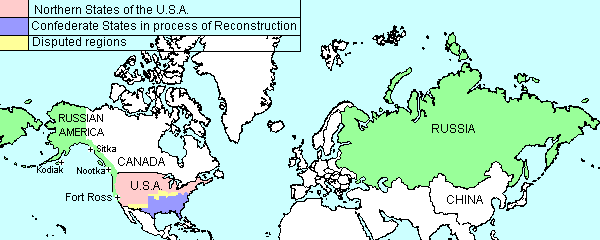
| As Alexander II began to react against the revolutionary groups, some of them started using terrorist tactics. Shots were fired at officials and at the Emperor; the Imperial Dining Room of the Winter Palace was blown up in 1880, and in 1881 Alexander II was assassinated. His son became the Emperor Alexander III | |
| Alexander III allowed some of the reforms to continue, but also tried to bolster the interests of the nobles and landlords. The result was increasing social tension, and an increased persecution of liberals and reformers by the government. In particular, actions against denominations and religions other than Russian Orthodoxy were greatly increased - Roman Catholics, Lutherans, and especially Jews were targets for persecution. Taxation was increased, and the peasants were hit especially hard - it was no longer possible for them to raise enough food on their plots of land. In 1891 there was a great famine, which sparked national discontent, and the revolutionary movement turned to Marxism Alexander III died in 1894 and was succeeded by his son Nicholas II |
|
|
Nicholas II attempted to continue the autocratic regime of his father and grandfather, but was not of a sufficiently strong character to force compliance. He and his wife, Princess Alexandra, both came under the influence of a disreputable "Holy man", Rasputin, who claimed that he could heal the Tsarevitch (the Tsar's son and heir) of the hemophilia he had inherited from his mother's family (Queen Victoria of England). In 1903 the revolutionary leader V. I. Ulyanov changed his name to Lenin and founded the Bolshevik party (an illegal party in Russia at that time). The situation continued to deteriorate Many of the peoples who had been under Russian control started to form nationalist groups, and press for reform or revolt - Finland, Poland, Ukraine, Armenia, Estonia, Latvia, Lithuainia, Kazan, Georgia, all were affected. Many of the Russian Jews turned to Zionism (the work towards reviving Hebrew as their national language, and to reclaiming a homeland in what was then Palestine) In the far East, Russia had spread into Korea, which Japan had just taken from China. In 1904 Japan sparked a war by attacking and sinking some of the Russian fleet which was at Port Arthur (Lüshunk), and then beat the Russian land forces in Korea. Russia had to withdraw and sign a peace treaty This sparked further resentment among the Russian people, and when police opened fire on a peaceful demonstration in front of the Winter Palace, and killed 1,000 workers a Revolution broke out. There followed several years of attempts by Nicholas II to restore order and appoint a Duma (similar to a Parliament), but World War I brought further complications and defeats for Russia In 1917 there was another demonstration of workers and women who were protesting the war and the scarcity of food. Nicholas ordered soldiers to fire on the demonstrators, but they refused to do so, and joined the demonstration. Fighting broke out, the Duma took control, formed a provisional government, and forced the Emperor and his son to abdicate. Nicholas and his family were kept at Tsarskoe Selo while decisions were made as to their future. The government wanted to send them to England, but the soviet party objected. They were sent to Tobolsk in Siberia, then to a house in Ekaterinburg in the Urals, where they were murdered in 1918 |
![]() Go here for the History of the period
Go here for the History of the period
Copyright © 1999 Shirley J. Rollinson, all Rights Reserved